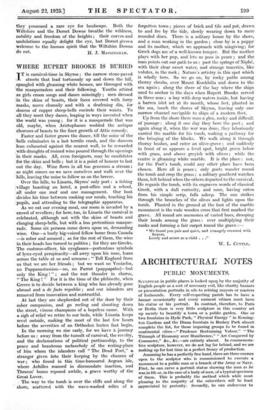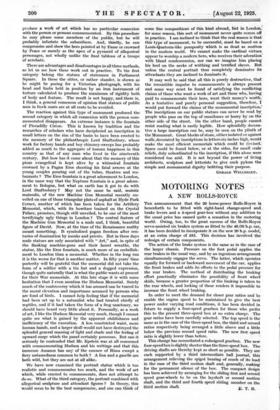ARCHITECTURAL NOTES
PUBLIC MONUMENTS.
Scuizrumn in public places is looked upos by the majority of English people as a sort of necessary evil, like charity bazaars or presentation portraits in oils to retiring mayors or masters of foxhounds. Every self-respecting parish has to have a bazaar occasionally and every eminent citizen must have his statue or his portrait. In contrast, therefore, to Paris or Berlin there is very little sculpture in this country set up merely to beautify a town or a public garden. One or two fountains in Hyde Park, " Physical Energy " in Kensing- ton Gardens and the Diana fountain in Bushey Park almost complete the list, for those imposing groups to be found in continental cities—" Prudence Restraining Valour," " The Triumph of Economy over Munificence," " Art Conquered by Commerce," &c., &c.—are entirely absent. In commemora- tive sculpture, however, we do not lag far behind, and we are making up for lost time in a perfect frenzy of production.
Assuming he has a perfectly free hand, there are three courses open to the sculptor who is commissioned to execute a monument to a public man or a branch of the Army or Navy. First, he can carve a portrait statue showing the man as he was in life or, in the case of a body of men, of a typical specimen of them. This is probably the method which while most pleasing to the majority of the subscribers will be least appreciated by posterity. Secondly, he can endeavour to produce a work of art which has no particular connexion with the person or persons commemorated. By this procedure he may please some members of the public, but - he will probably infuriate the subscribers. And, thirdly, he can compromise and show the hero pointed at by Fame or crowned by Peace or merely as the apex of a pyramid of allegorical personages, not wholly unlike the final tableau of a troupe of acrobats.
There are advantages and disadvantages in all three methods, so let us see how these work out in practice. To the first categciry belong the statues of statesmen in Parliament Square. In these the sitter, or rather stander, is shown as he might be posing for a Victorian photograph, with his head and limbs held in Position 'by an iron instrument of torture calculated to produce the maximum of rigidity both of body and feature. The result is not happy, and there is, I think, a general consensus of opinion that statues of public men in frock coats are at all costs to be avoided.
The reaction against this type of monument produced the second category in which all connexion with the person com- memorated disappears. An extreme instance is the fountain of Piccadilly Circus. This is known by tradition and the researches of scholars who have deciphered an inscription in small letters on the rim of the basin to have been erected to the memory of the philanthropic Lord Shaftesbury, whose work for factory hands and boy chimney-sweeps has probably added as much to the aggregate of human happiness in this country as that of any man who lived in the nineteenth century. But how has it come about that the memory of this pious *evangelical, is kept alive by a whimsical fountain crowned by a Pagan Eros shooting his fatal arrows at the young couples pouring out of the tubes, theatres and res- taurants ? The ErOs fountain is a great adornment to London, in the same way that the Neptune fountain is a great adorn- ment to Bologna, but what on earth has it got to do with Lord Shaftesbury ? May not the same be said, rnutatis mutandis, of the new Machine Gun Memorial recently un- veiled on one of those triangular plats of asphalt at Hyde Park Corner, another of which has been taken for the Artillery Memorial, which, with its howitzer trained on the Crystal Palace, promises, though still unveiled, to be one of the most terrifyingly ugly things in London ? The central feature of the Machine Gun Memorial is a nude and, I think, beautiful figure of David. Now, at the time of the Renaissance nudity meant something. It symbolized pagan freedom after cen- turies of domination by monks and priests. But in these days nude statues are only associated with " Art," and, in spite of the flanking machine-guns and their laurel wreathi, the statue, like the Eros fountain, is much more of an embellish- ment to London than a memorial. Whether in the long run it is the worse for that is another matter. In fifty years' time posterity will be grateful that the memorial did not take the form of a soldier with a tin hat and a dogged expression, though quite naturally that is what the public wants at present for their War memorials. At this late stage it is with some hesitation that I even mention the Hudson Memorial. Surely much of the controversy which it has aroused can be traced to the moral elevation and importance assumed by persons who are fond of birds. I cannot help feeling that if the memorial had been set up to a naturalist who had treated chiefly of reptiles, and if it had taken the form of a frog sanctuary, we should have heard very little about it. Personally, as a work of art, I like the Hudson Memorial very much, though I cannot quite see what is gained by the apparent childishness and inefficiency of the execution. A less constricted waist, more human hands, and a larger skull would not have destroyed the splendid general massing of light and shade and the feeling of upward surge which the panel certainly possesses. But can- it seriously be contended that Mr. Epstein was at all concerned with commemorating Hudson and his writings and that this immense Amazon has any of the essence of Rims except a fiery untamedness common to both ? A lion and a gazelle are both wild, but they are not at all alike.,
We have now examined the portrait statue which is too realistic and commemorates too much, and the work of art which, while erected to commemorate, does not attempt to do so. What of the third category, the portrait combined with allegorical sculpture and attendant figures ? In theory, this would seem to be the best compromise, and one can think of
some fine compositions of this kind abroad, but in London,' for some reason, this sort of monument never quite comes off in practice. I am inclined to think that the real reason is that' this type of monument, to be successful, must be based on a' Louis-Quatorze-like pomposity which is as dead as mutton in the modern world. We cannot make the cardinal virtues, appear to worship a modern hero, who receives their adoration with bland condescension, nor can we imagine him placing his heel on the necks of writhing and terrified slaves. But unless the central portrait thus completely dominates its attendants they are inclined to dominate it.
It may well be said that all this is purely destructive, that the irresistible impulse to commemorate is always present and some way must be found of satisfying the conflicting claims of those who want a work of art and those who, having paid to commemorate their hero, want their money's worth.' As a tentative and purely personal suggestion, therefore, I would put forward the claims of the monumental inscription.' The inscriptions on our public statues can never be read by, people who pass on the top of omnibuses or hurry by on the other side of the street. On the other hand, people cannot resist reading what is easily legible. How splendidly decora- tive a large inscription can be, may be seen on the plinth of the Monument. Great blocks of stone, either isolated or against walls, decorated by inscriptions in letters six inches high, would make the most efficient memorials' which could be devised.
Space could be found below, or at the sides, for small scale reliefs, duly subordinated to the inscription, if this alone were considered too arid. It is not beyond the power of living architects, sculptors and letterists to give such pylons the simple and monumental dignity befitting their purpose.
GERALD WELLESLEY.



































 Previous page
Previous page